interior lights TOYOTA TACOMA 2011 Owners Manual (in English)
[x] Cancel search | Manufacturer: TOYOTA, Model Year: 2011, Model line: TACOMA, Model: TOYOTA TACOMA 2011Pages: 548, PDF Size: 9.86 MB
Page 4 of 548

TABLE OF CONTENTSIndex
4
3-4. Using the interior lightsInterior lights list ................. 308
• Interior light ....................... 309
• Personal lights ................. 309
3-5. Using the storage features List of storage features....... 310
• Glove box ........................ 311
• Console boxes ................. 311
• Cup holders ...................... 312
• Bottle holders ................... 314
• Auxiliary boxes ................. 316
• Overhead console ............ 318
3-6. Other interior features Sun visors .......................... 319
Vanity mirrors ..................... 320
Clock .................................. 321
Outside temperature display (vehicles with accessory
meter) ............................... 322
Cigarette lighter .................. 323
Power outlet (12V DC) ....... 324
Power outlet (115V AC) ..... 325
Seatback table ................... 331
Floor mat ............................ 332
Luggage compartment features ............................ 334
Garage door opener box .... 343
Compass (vehicles with accessory meter).............. 347 4-1. Maintenance and care
Cleaning and protecting the vehicle exterior ........... 354
Cleaning and protecting the vehicle interior ............ 357
4-2. Maintenance Maintenance requirements .................... 360
General maintenance ......... 362
Emission inspection and maintenance (I/M)
programs .......................... 365
4-3. Do-it-yourself maintenance Do-it-yourself service precautions ....................... 366
Hood ................................... 370
Engine compartment .......... 372
Tires.................................... 388
Tire inflation pressure ......... 396
Wheels................................ 401
Air conditioning filter ........... 403
Wireless remote control battery .............................. 406
Checking and replacing fuses ................................. 408
Light bulbs .......................... 418
4Maintenance and care
Page 13 of 548
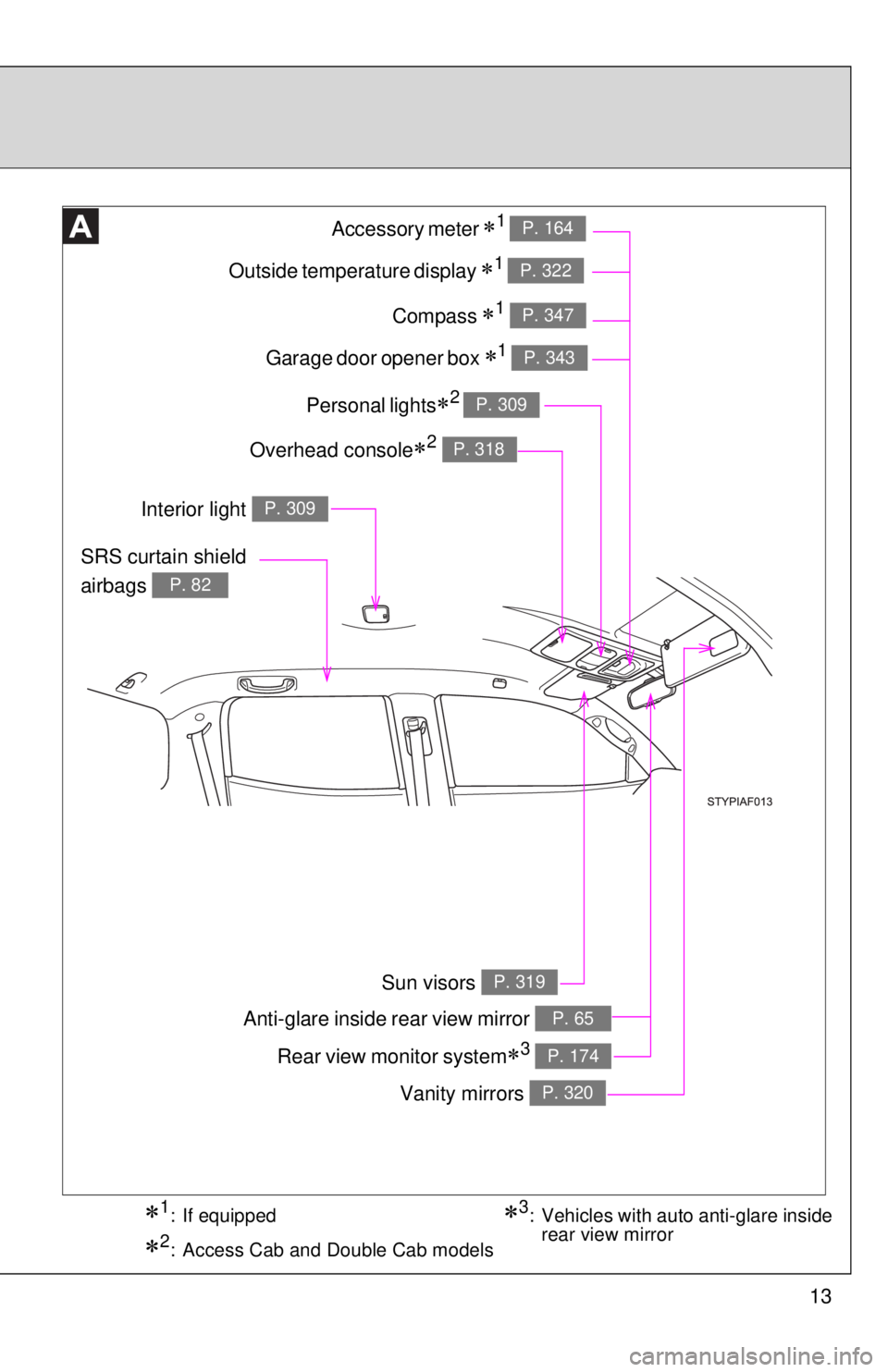
13
Anti-glare inside rear view mirror P. 65
Sun visors P. 319
SRS curtain shield
airbags
P. 82
Vanity mirrors P. 320
Interior light P. 309
Rear view monitor system3 P. 174
Overhead console2 P. 318
Garage door opener box 1 P. 343
Compass 1 P. 347
Personal lights2 P. 309
Outside temperature display 1 P. 322
Accessory meter 1 P. 164
3: Vehicles with auto anti-glare inside rear view mirror1: If equipped
2: Access Cab and Double Cab models
Page 235 of 548
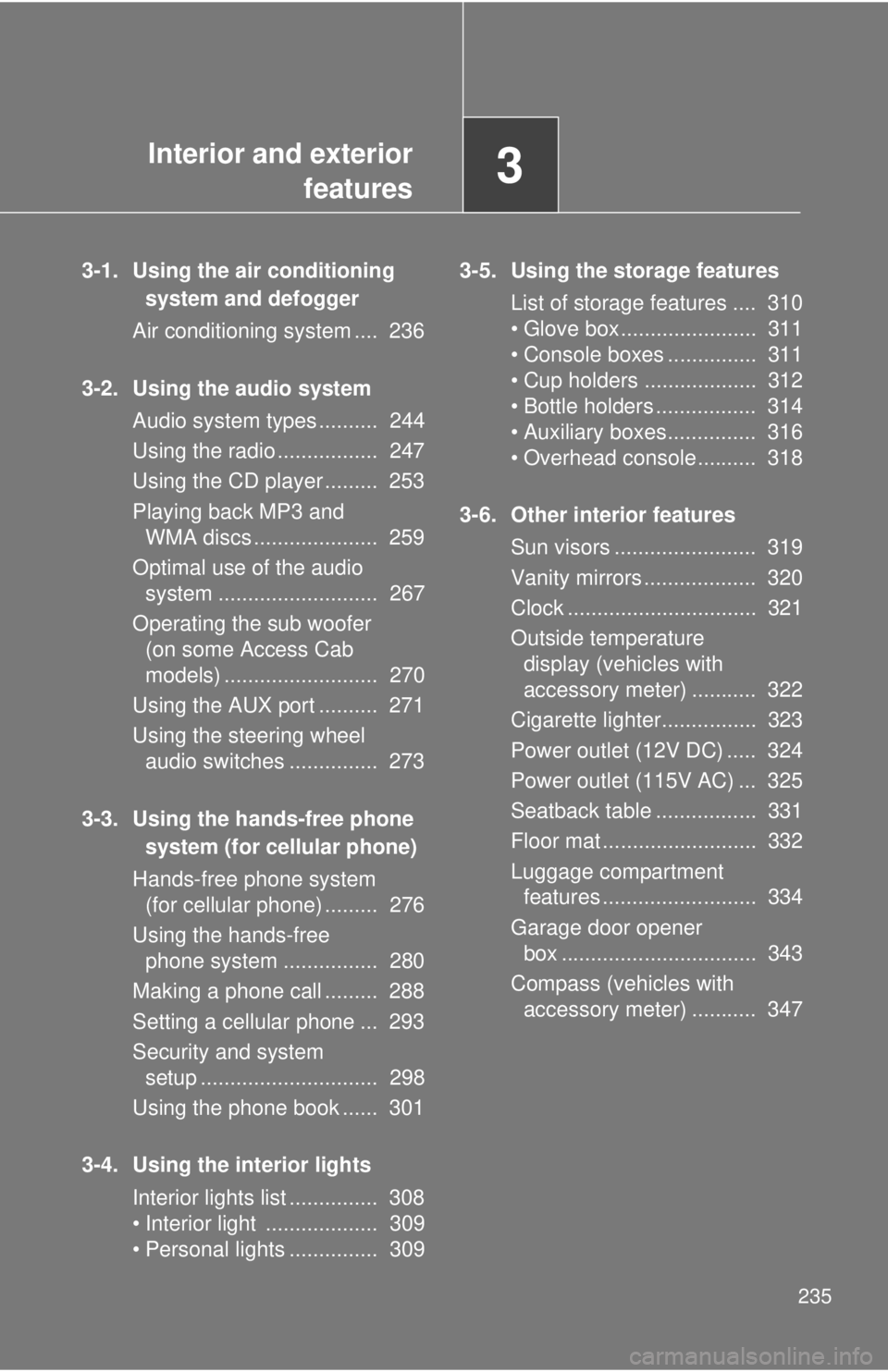
Interior and exterior features3
235
3-1. Using the air conditioning
system and defogger
Air conditioning system .... 236
3-2. Using the audio system Audio system types .......... 244
Using the radio ................. 247
Using the CD player ......... 253
Playing back MP3 andWMA discs ..................... 259
Optimal use of the audio system ........................... 267
Operating the sub woofer (on some Access Cab
models) .......................... 270
Using the AUX port .......... 271
Using the steering wheel audio switches ............... 273
3-3. Using the hands-free phone system (for cellular phone)
Hands-free phone system (for cellular phone) ......... 276
Using the hands-free phone system ................ 280
Making a phone call ......... 288
Setting a cellular phone ... 293
Security and system setup .............................. 298
Using the phone book ...... 301
3-4. Using the interior lights Interior lights list ............... 308
• Interior light ................... 309
• Personal lights ............... 309 3-5. Using the storage features
List of storage features .... 310
• Glove box....................... 311
• Console boxes ............... 311
• Cup holders ................... 312
• Bottle holders ................. 314
• Auxiliary boxes ............... 316
• Overhead console .......... 318
3-6. Other interior features Sun visors ........................ 319
Vanity mirrors ................... 320
Clock ................................ 321
Outside temperaturedisplay (vehicles with
accessory meter) ........... 322
Cigarette lighter................ 323
Power outlet (12V DC) ..... 324
Power outlet (115V AC) ... 325
Seatback table ................. 331
Floor mat .......................... 332
Luggage compartment features .......................... 334
Garage door opener box ................................. 343
Compass (vehicles with accessory meter) ........... 347
Page 308 of 548
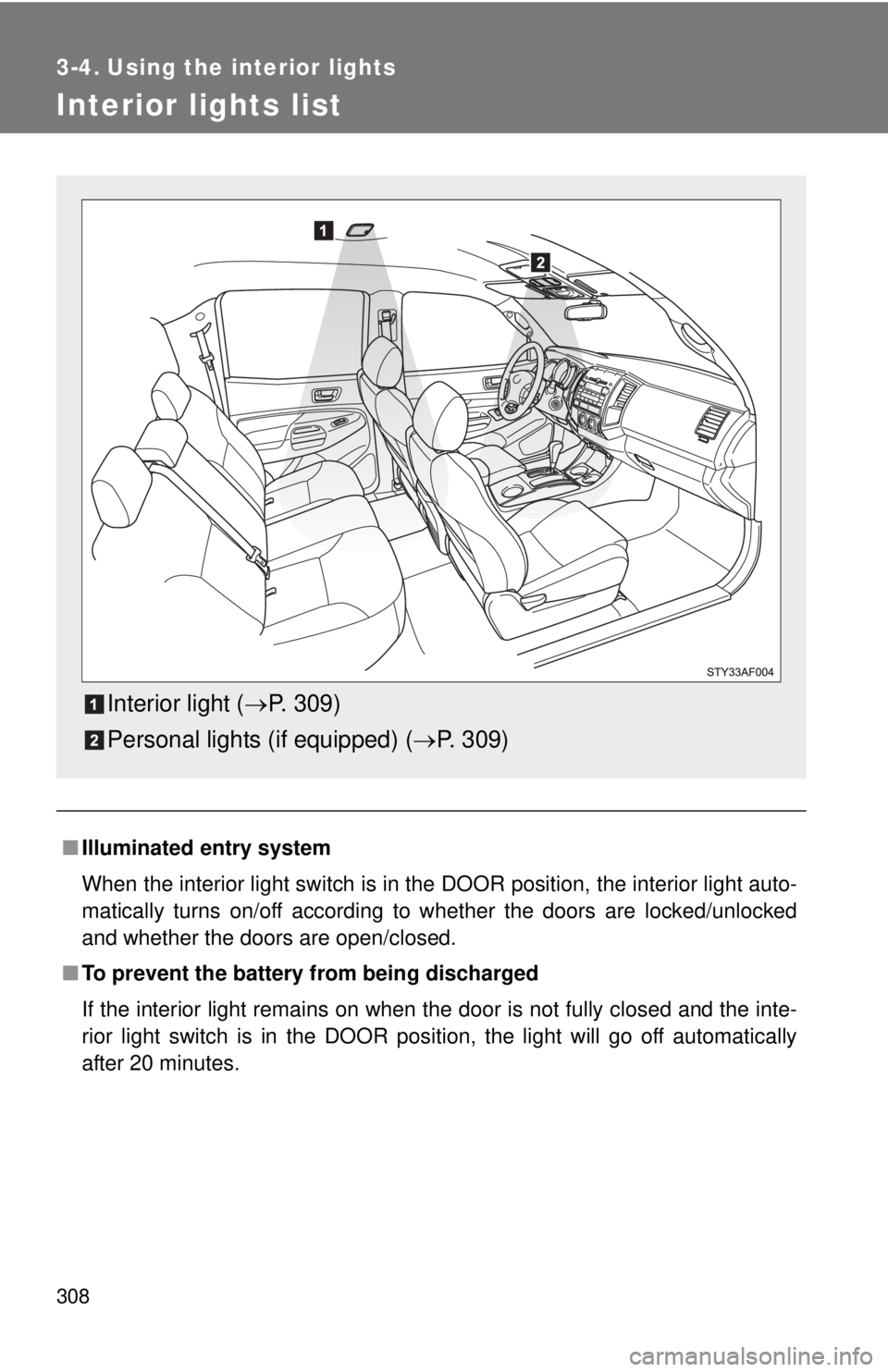
308
3-4. Using the interior lights
Interior lights list
■Illuminated entry system
When the interior light switch is in the DOOR position, the interior light auto-
matically turns on/off according to whether the doors are locked/unlocked
and whether the doors are open/closed.
■ To prevent the battery from being discharged
If the interior light remains on when the door is not fully closed and the inte-
rior light switch is in the DOOR position, the light will go off automatically
after 20 minutes.
Interior light ( P. 309)
Personal lights (if equipped) ( P. 309)
Page 309 of 548
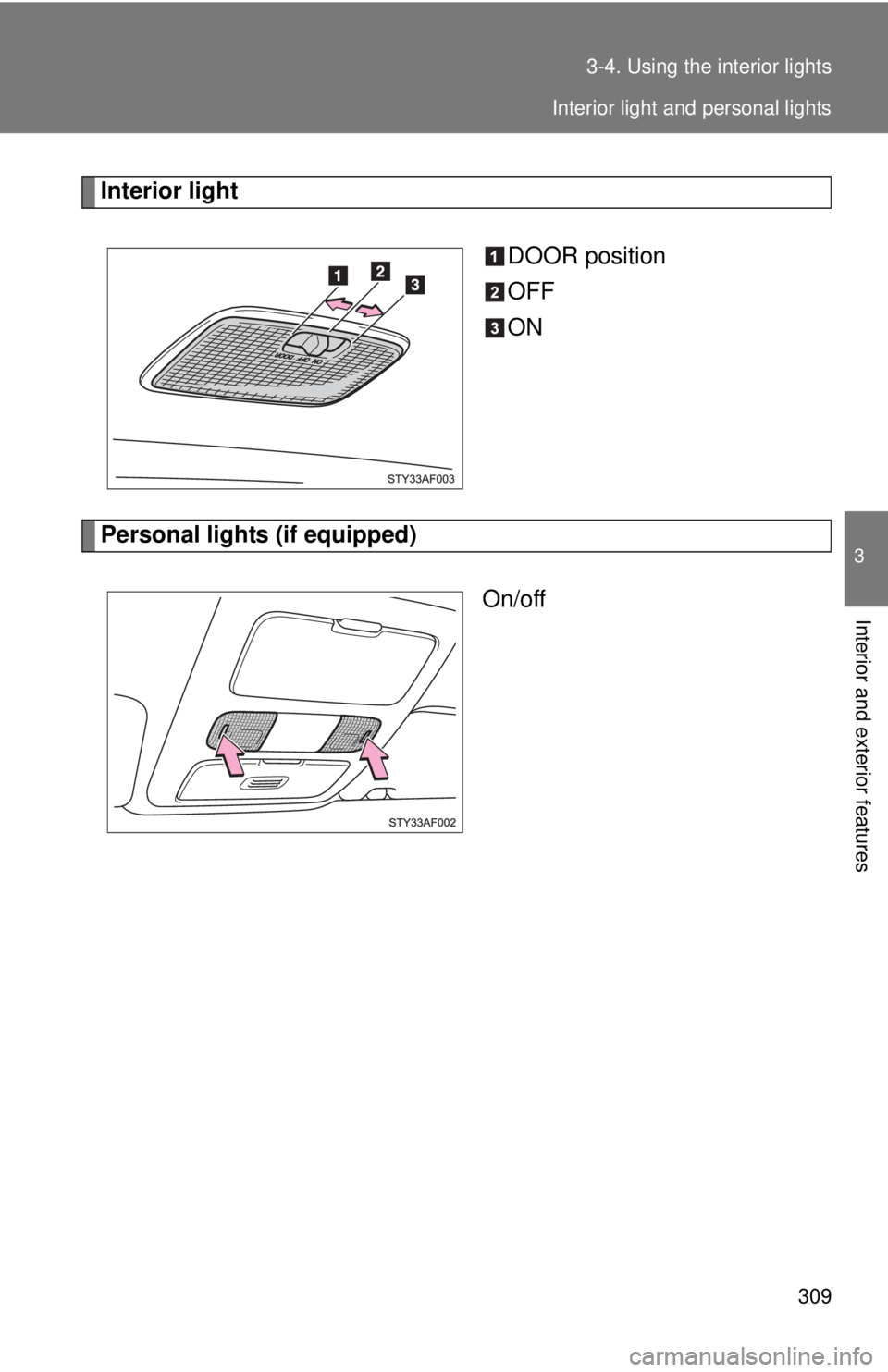
309
3-4. Using the interior lights
3
Interior and exterior features
Interior light
DOOR position
OFF
ON
Personal lights (if equipped)On/off
Interior light and personal lights
Page 327 of 548
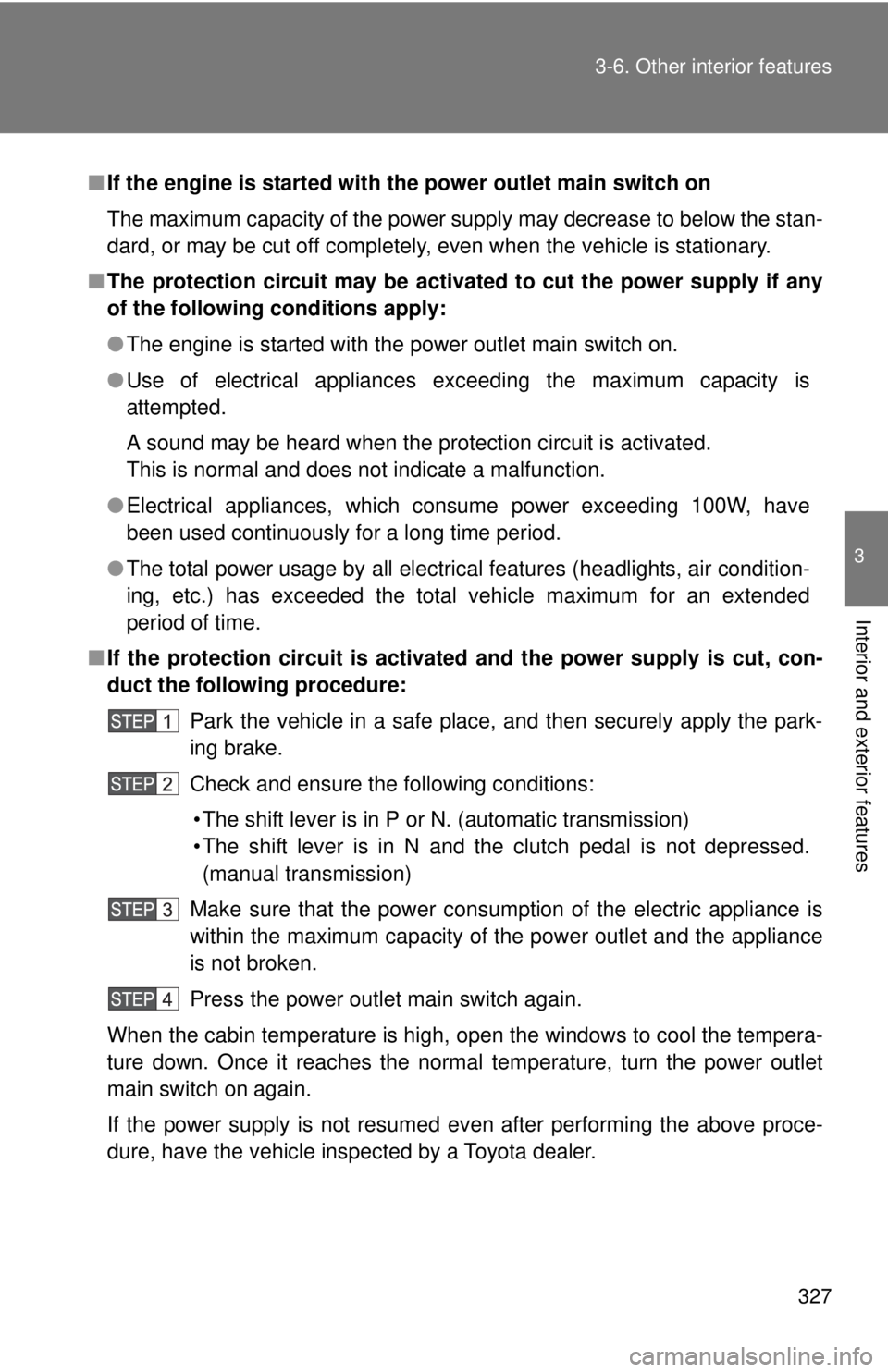
327
3-6. Other interior features
3
Interior and exterior features
■
If the engine is started with the power outlet main switch on
The maximum capacity of the power supply may decrease to below the stan-
dard, or may be cut off completely, even when the vehicle is stationary.
■ The protection circuit may be activated to cut the power supply if any
of the following conditions apply:
●The engine is started with the power outlet main switch on.
● Use of electrical appliances exceeding the maximum capacity is
attempted.
A sound may be heard when the protection circuit is activated.
This is normal and does not indicate a malfunction.
● Electrical appliances, which consume power exceeding 100W, have
been used continuously for a long time period.
● The total power usage by all electrical features (headlights, air condition-
ing, etc.) has exceeded the total vehicle maximum for an extended
period of time.
■ If the protection circuit is activated and the power supply is cut, con-
duct the following procedure:
Park the vehicle in a safe place, and then securely apply the park-
ing brake.
Check and ensure the following conditions:• The shift lever is in P or N. (automatic transmission)
• The shift lever is in N and the clutch pedal is not depressed. (manual transmission)
Make sure that the power consumption of the electric appliance is
within the maximum capacity of the power outlet and the appliance
is not broken.
Press the power outlet main switch again.
When the cabin temperature is high, open the windows to cool the tempera-
ture down. Once it reaches the normal temperature, turn the power outlet
main switch on again.
If the power supply is not resumed even after performing the above proce-
dure, have the vehicle inspected by a Toyota dealer.
Page 329 of 548

329
3-6. Other interior features
3
Interior and exterior features
NOTICE
■
To avoid damaging the power outlet and the plug
●Close the power outlet lid when not in use.
● Foreign objects or liquids that enter the power outlet may cause a short
circuit.
● Do not use plug adaptors to connect too many plugs to the power outlet.
● After inserting a plug, gently close the power outlet lid.
■ To prevent the fuse from being blown
Do not use a 115V AC appliance that requires more than maximum capacity.
If a 115V AC appliance that consumes more than maximum capacity is
used, the protection circuit will cut the power supply.
■ Appliances that may not ope rate properly (115V AC)
The following 115V AC appliances may not operate even if their power con-
sumption is under maximum capacity.
● Appliances with high initial peak wattage
● Measuring devices that process precise data
● Other appliances that require an extremely stable power supply
■ To prevent the battery from being discharged
Turn off all the vehicle’s electronic equipment and accessories, such as the
headlights and air conditioning, when electrical appliances that consume in
excess of 100W are used continuously for long periods of time.
■ To prevent any damage caused by heat
●Do not use any electrical appliances that give off intense heat such as
toasters, in any locations including the internal or external trim, seats and
deck.
● Do not use any electrical appliances, which are easily affected by vibration
or heat, inside the vehicle.
Vibration while driving, or the heat of the sun while parking, may result in
damage to those electrical appliances.
Page 363 of 548
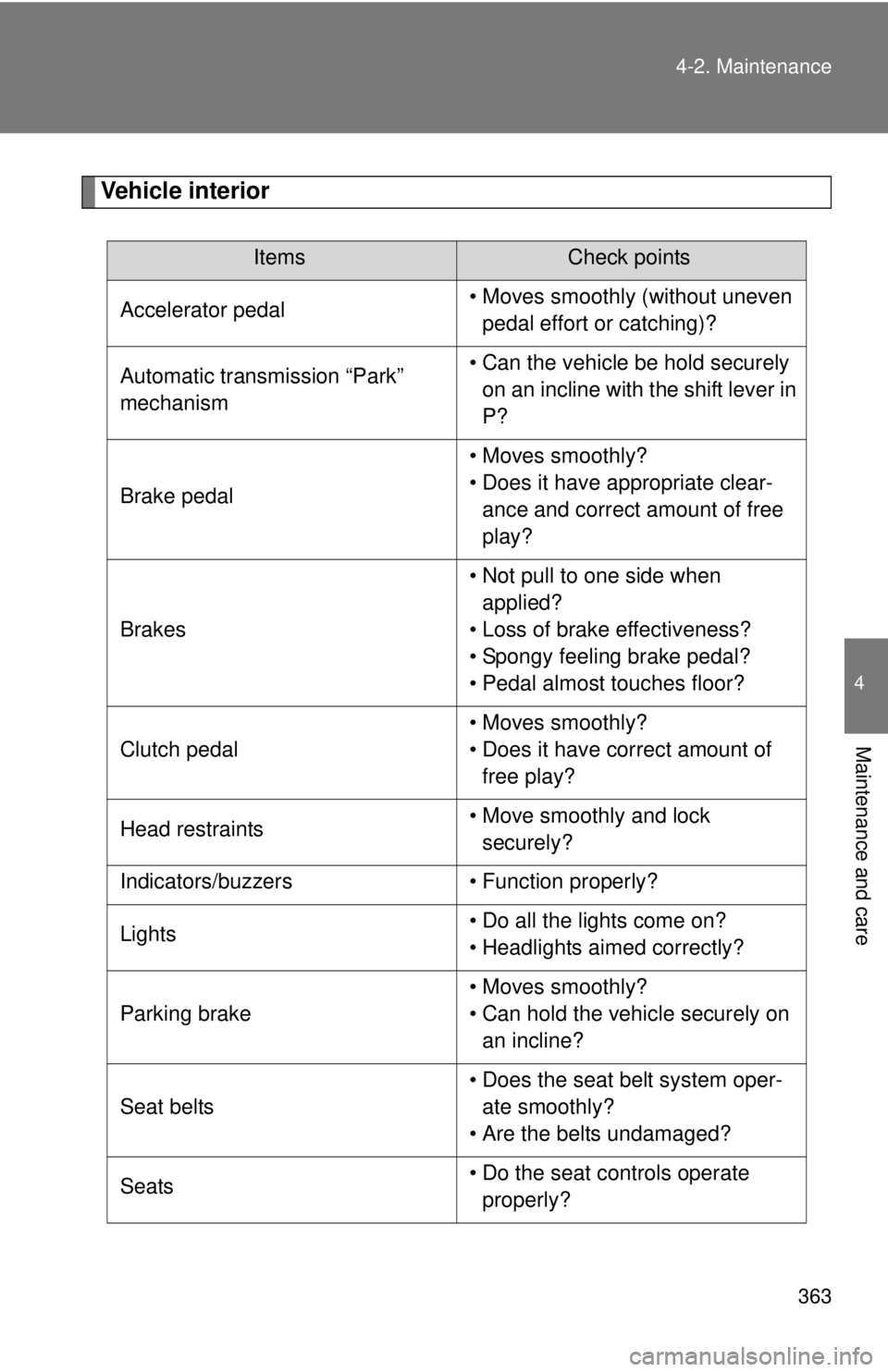
363
4-2. Maintenance
4
Maintenance and care
Vehicle interior
ItemsCheck points
Accelerator pedal • Moves smoothly (without uneven
pedal effort or catching)?
Automatic transmission “Park”
mechanism • Can the vehicle be hold securely
on an incline with the shift lever in
P?
Brake pedal • Moves smoothly?
• Does it have appropriate clear-
ance and correct amount of free
play?
Brakes • Not pull to one side when
applied?
• Loss of brake effectiveness?
• Spongy feeling brake pedal?
• Pedal almost touches floor?
Clutch pedal • Moves smoothly?
• Does it have correct amount of
free play?
Head restraints • Move smoothly and lock
securely?
Indicators/buzzers • Function properly?
Lights • Do all the lights come on?
• Headlights aimed correctly?
Parking brake • Moves smoothly?
• Can hold the vehicle securely on
an incline?
Seat belts • Does the seat belt system oper-
ate smoothly?
• Are the belts undamaged?
Seats • Do the seat controls operate
properly?
Page 413 of 548
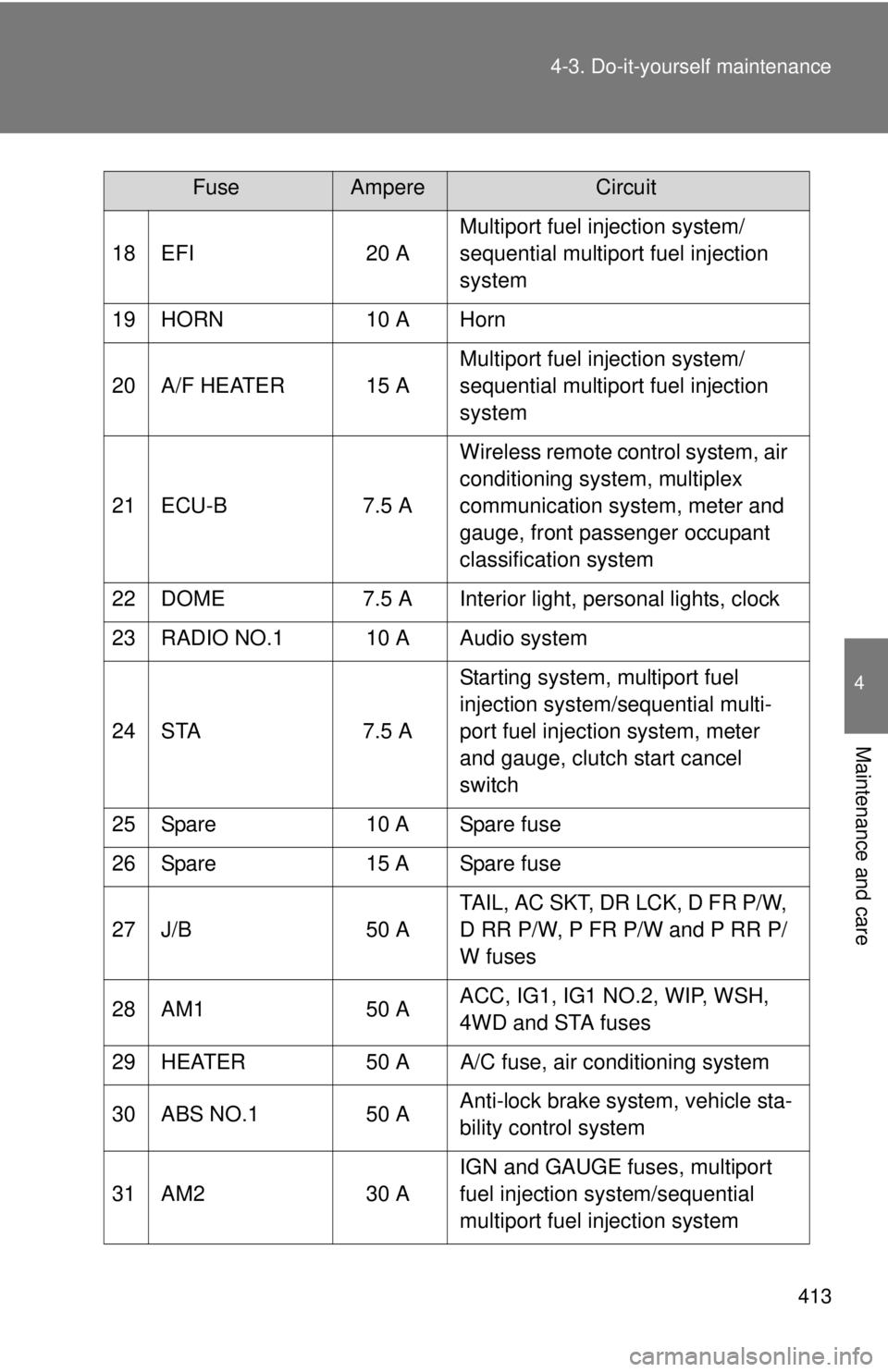
413
4-3. Do-it-yourself maintenance
4
Maintenance and care
18 EFI
20 AMultiport fuel injection system/
sequential multiport fuel injection
system
19 HORN 10 A Horn
20 A/F HEATER 15 A Multiport fuel injection system/
sequential multiport fuel injection
system
21 ECU-B 7.5 AWireless remote control system, air
conditioning system, multiplex
communication system, meter and
gauge, front passenger occupant
classification system
22 DOME 7.5 A Interior light, personal lights, clock
23 RADIO NO.1 10 A Audio system
24 STA 7.5 AStarting system, multiport fuel
injection system/sequential multi-
port fuel injection system, meter
and gauge, clutch start cancel
switch
25 Spare 10 A Spare fuse
26 Spare 15 A Spare fuse
27 J/B 50 ATAIL, AC SKT, DR LCK, D FR P/W,
D RR P/W, P FR P/W and P RR P/
W fuses
28 AM1 50 AACC, IG1, IG1 NO.2, WIP, WSH,
4WD and STA fuses
29 HEATER 50 A A/C fuse, air conditioning system
30 ABS NO.1 50 AAnti-lock brake system, vehicle sta-
bility control system
31 AM2 30 AIGN and GAUGE fuses, multiport
fuel injection system/sequential
multiport fuel injection system
FuseAmpereCircuit
Page 468 of 548
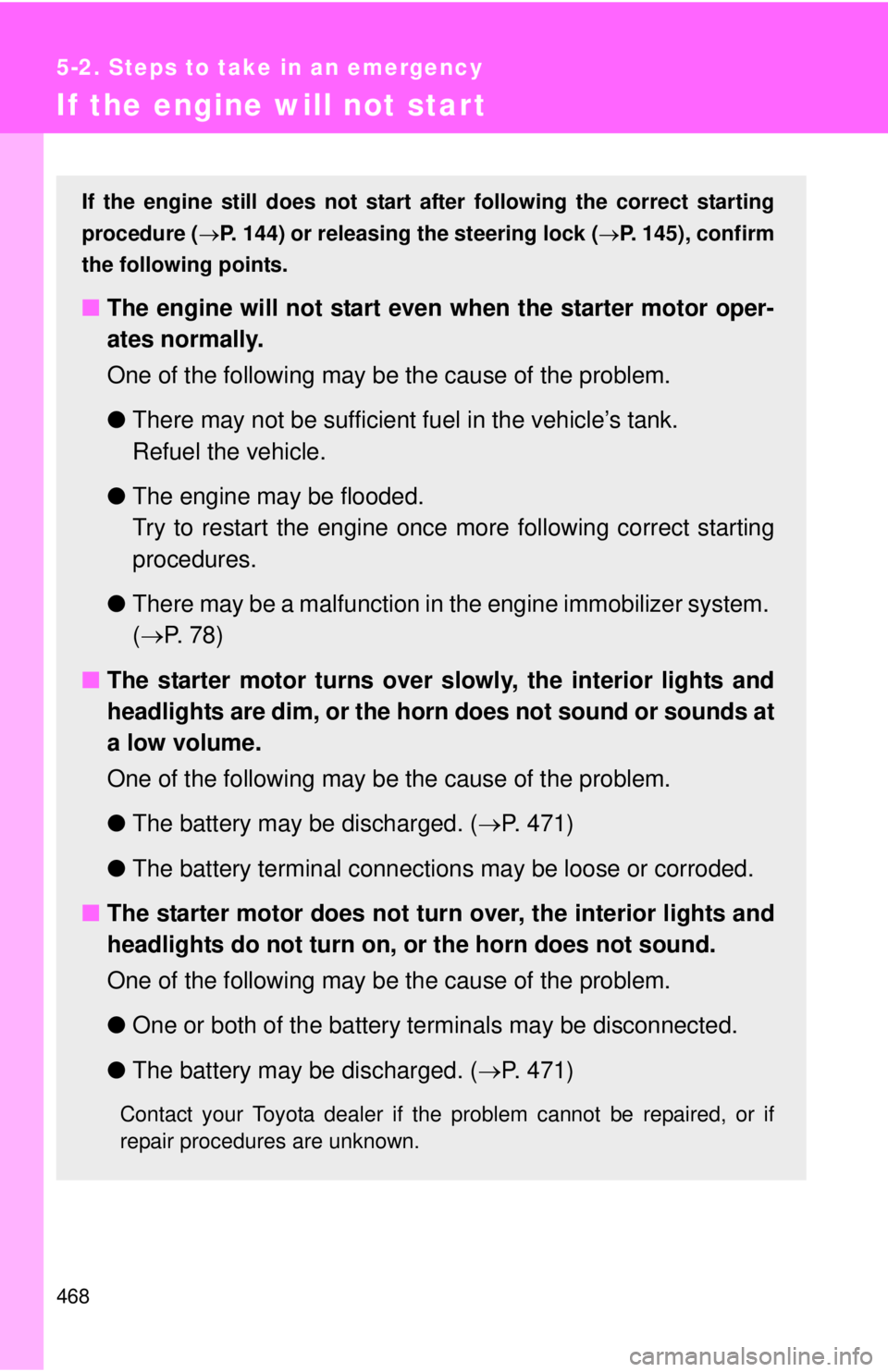
468
5-2. Steps to take in an emergency
If the engine will not star t
If the engine still does not start after following the correct starting
procedure ( P. 144) or releasing the steering lock (P. 145), confirm
the following points.
■ The engine will not start even when the starter motor oper-
ates normally.
One of the following may be the cause of the problem.
●There may not be sufficient fuel in the vehicle’s tank.
Refuel the vehicle.
● The engine may be flooded.
Try to restart the engine once more following correct starting
procedures.
● There may be a malfunction in the engine immobilizer system.
( P. 7 8 )
■ The starter motor turns over slowly, the interior lights and
headlights are dim, or the horn does not sound or sounds at
a low volume.
One of the following may be the cause of the problem.
●The battery may be discharged. ( P. 471)
● The battery terminal connec tions may be loose or corroded.
■ The starter motor does not turn over, the interior lights and
headlights do not turn on, or the horn does not sound.
One of the following may be the cause of the problem.
● One or both of the battery terminals may be disconnected.
● The battery may be discharged. ( P. 471)
Contact your Toyota dealer if the problem cannot be repaired, or if
repair procedures are unknown.